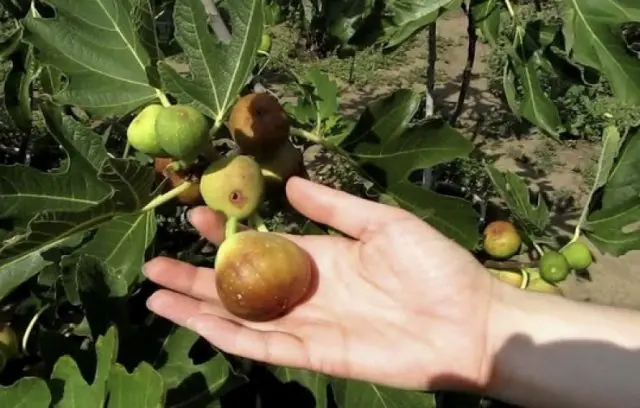Contents
The Brunswick fig has been known for a long time. One of the most frost-resistant varieties was distributed in the southern regions of the country among amateur gardeners. Enthusiasts also grow figs in the middle lane, providing a reliable special shelter or transferring them to a large tub, which stands in a frost-free room.
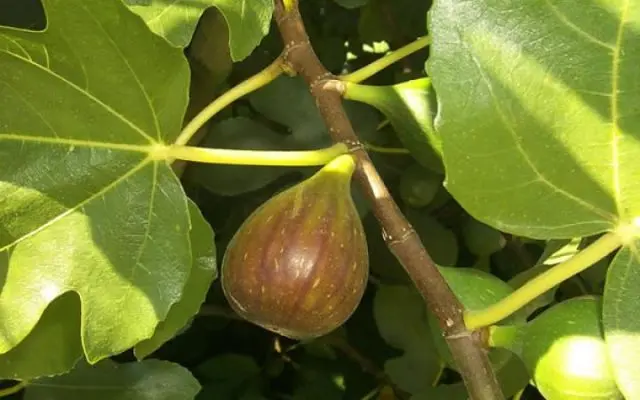
Description of the Brunswick fig
In the subtropics, the tree grows over 2 m, a flat-rounded crown is created by spreading branches. The roots of figs are just as branched, sometimes more than 10 m in diameter and 5-7 m deep. In the climate, even in the south, Brunswick figs are not allowed to have such a height, regularly pruning branches, and when planting they take care to prevent distant spread of roots. The leaves are very different from any known culture: very large, up to 20-25 cm, with deeply indented lobes. Thick and rough on top, hairy and soft underneath. The female-type flowers are also unusual, inconspicuous, located inside the future fruit formation, which grows in the form of an irregular, elongated ball.
The early self-fertile Brunswick figs produce 2 full crops with sufficient heat:
- in the middle of summer;
- at the beginning of autumn.
Variety Brunsvik ripens within 2,5-3 months. The fruits reach the degree of technical ripeness in 25-60 days after harvest.
In mid-summer, the first wave of ripe Brunswick figs is rather scarce. The fruits are large, with a flat top, 5×7 cm in size, weighing up to 100 g and more. The integumentary shade of the skin is often purple. There is a large cavity in the pink juicy pulp. The taste is sweet, pleasant. Autumn fruits of figs are irregular, pear-shaped, small – 5×4 cm, do not exceed 70 g, may not ripen in the climate of the middle zone due to the early onset of frosts. The thin fleecy skin is light green, in the sun it acquires a yellow-brown blush. Second harvest fruits have tender, reddish-brown flesh with a high sugar content and a small cavity. Seeds are small and common.
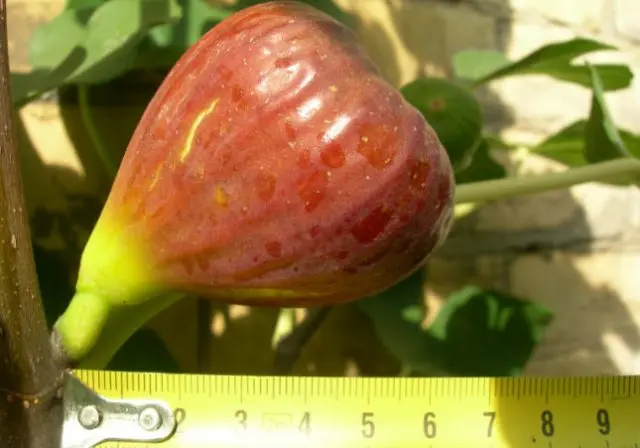
Frost resistance of figs Brunswick
According to the description, when grown outdoors, Brunswick figs can withstand frosts down to -27 ° C in a sheltered state. However, in the reviews, many gardeners indicate that prolonged low temperatures below -20 ° C lead to freezing of the plant. The Brunsvik variety has the ability to recover after a harsh winter, to start up new shoots from the root system preserved under cover. The main task of the gardener is to keep the roots from freezing. This is achieved by specific hiding methods. The culture is grown in greenhouses or room conditions, planted in tubs in those zones of plant frost resistance, where the maximum minus indicators fall below the level of -18-12 ° C.
Pros and cons of the Brunswick fig variety
The fruits of this southern culture are so excellent in taste that gardeners dream of new breeding achievements. Perhaps somewhere they are already working on breeding more frost-resistant varieties of figs. For most gardeners in the middle lane, the unreality of wintering the plant in the open field is the only drawback of the Brunsvik variety. Although it is still the most cold-resistant of its kind.
Advantages of the Brunswick variety:
- figs are suitable for growing in climates where sub-zero temperatures briefly drop to -20 ° C in winter;
- high yield;
- excellent taste qualities;
- self-fertility;
- precocity;
- the possibility of two-time collection of sweet fruits.
Growing figs Brunswick
Remontant figs Brunswick with light green fruits are planted, taking into account the specific requirements for the care of the southern culture.
Selection and preparation of the landing site
Figs are unpretentious to soils: they can develop well on sandy, loamy, clay and calcareous. But the taste of fruits depends on the amount of minerals in the planting pit and on the site. High acidity of the soil is not suitable for the culture. One of the important requirements for the successful cultivation of figs is a sufficient amount of moisture and at the same time good soil drainage. In the middle lane for the Brunsvik variety, it is better to dig a trench in advance along with a hole where the plant is placed for winter shelter. For planting substrate, garden soil is mixed with an equal part of humus or compost and half of the sand is added. The landing site should be only on the south side, under the protection of buildings from the north.
Perlite is added to the tubs to the substrate, in addition, a drainage layer is arranged. Indoor plants of the variety are transplanted after 2-3 years, constantly cutting off the roots during transshipment.
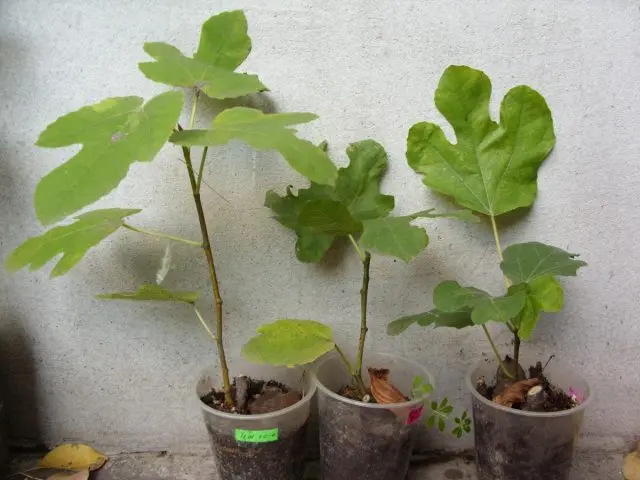
Rules of landing
When planting the Brunsvik variety, they fulfill the requirements:
- the landing pit should be 2 times the volume of the container from the nursery;
- when planting figs, the stem is arranged in the soil deeper than it grew in the container;
- near the trunk, stepping back 20-30 cm, clog the support;
- straighten the roots, sprinkle with the remaining substrate, while compacting it several times;
- 10 liters of water are poured, a day later they are moistened again with this amount and the hole is mulched.
Watering and top dressing
Irrigate Brunswick figs moderately, given the age of the plant:
- in the first 2-3 years, they are watered every 7 days in a bucket per tree;
- adult specimens – once every 2 weeks, 10-12 liters;
- in the phase of fruit ripeness, watering is not carried out;
- the last watering is applied after harvesting the fruits in September.
The culture is fed after 15 days:
- nitrogen preparations are used in spring;
- during flowering – complex, with phosphorus;
- potassium compounds are introduced in the phase of increasing ovaries.
It is convenient to carry out foliar feeding with ready-made balanced means. A good fertilizer for figs is organic. A prerequisite for top dressing is application with watering for better absorption of nutrients.
Trimming
In the Brunsvik fig, judging by the description of the variety and photo, in the southern regions they form a spreading cup-shaped crown, with a bole height of 40-60 cm. In the middle lane there is a two-meter bush, which is easier to bend to the ground for shelter in winter. In the spring, shoots thickening the crown are removed. Fan pruning is also practiced, when all branches that grow vertically are cut from a three-year-old seedling. The lower shoots are bent with the help of improvised means after the tree has been watered. Branches older than 5 years are cut in the fall at ground level, because they no longer bend down when covered. New shoots of the Brunsvik variety come into fruition in a year.
Preparation for winter
In the gardens of the middle climatic zone, the vines of the Brunswick fig, formed by a bush, are bent down and dug into pre-prepared trenches. The branches bend gradually, starting from the day the last fruits are removed. In regions with mild winters, the entire tree is wrapped up after the onset of frost. The trunk circle is mulched with sawdust, peat or spruce branches. In the Crimea, the Brunsvik variety is grown without winter shelter.
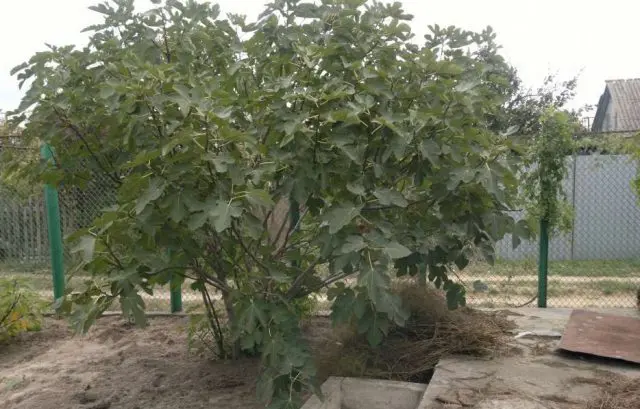
Harvesting
In figs of this variety, the fruits are first ripened in the first decade of July, the second harvest in September. Autumn fruiting lasts about a month. Ripe fruits are removed, then green ones for ripening. Use fresh, for conservation and drying.
Diseases and pests
Figs are threatened by the fungal disease Fusarium, which first affects the roots and lower part of the trunk. Then the plant dies. Affected specimens are removed from the site. The culture is parasitized by aphids, moths, psyllids, which destroy leaves, damage fruits, and carry pathogens of fungal and viral diseases. They prevent the reproduction of pests and the spread of diseases by autumn harvesting of foliage and spraying on the kidneys with copper-containing preparations, treatment with fungicides, insecticides.
Brunswick fig reviews
Conclusion
The Brunswick fig, the most frost-resistant variety of the species, is cultivated by many enthusiastic gardeners. Before purchasing a seedling, they carefully study the specifics of growing exotic. Creating the right conditions will make it possible to enjoy the legendary fruits.
